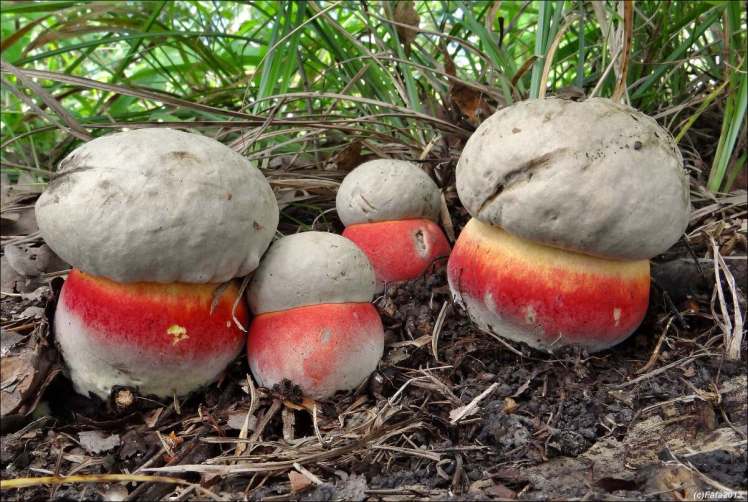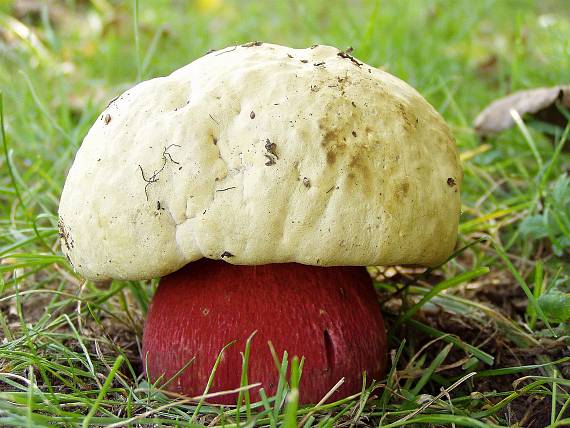Hríb satanský ENG
BOLETUS SATANAS LENZ

Rubroboletus satanas, commonly known as the Satan’s bolete is a basidiomycete fungus of the bolete family. It was known scientifically as Boletus satanas until 2014. Found on chalky soil in mixed woodlands in the southern, warmer regions of Europe, it is generally regarded as a poisonous mushroom, with predominantly gastrointestinal symptoms of nausea and violent vomiting occurring if eaten raw or fried. However, reports of poisoning are rare due to its odd appearance and at times putrid smell minimising casual experimentation. There are reports of its traditional consumption in the former Czechoslovakia and Italy after thorough cooking (frying does not remove the toxin).[citation needed]
The squat, brightly coloured fruiting bodies are large and imposing, with a pale dull-coloured velvety cap up to 30 cm (12 in) wide, blood red pores and bulbous red-patterned stalk. The flesh turns blue when cut or bruised. There is a smell of carrion, more noticeable with age. It is the largest bolete growing in Europe.
Taxonomy
Long known as Boletus satanas, the Satan’s bolete was described by German mycologist Harald Othmar Lenz in 1831, who gave it its sinister name, σατανᾶς satanas ‘of Satan’, derived from Hebrew via Ancient Greek, after he felt ill from its “emanations” while describing it. He also knew of several reports of diarrhea and sickness from those who had eaten it. American mycologist Harry D. Thiers concluded that material from North America matches the species description,however genetic testing has confirmed that the western North American collections are Rubroboletus eastwoodiae.
Genetic analysis published in 2013 showed that Satan’s bolete and many (but not all) red-pored boletes were part of a dupainii clade (named for B. dupainii), well-removed from the core group of Boletus edulis and relatives within the Boletineae. This indicated that it would need placing in a new genus. It was transferred to the new genus Rubroboletus in 2014 along with several other allied reddish colored, blue-staining bolete species. Genetic testing on several species of the genus showed that R. satanas was closely related to R. pulchrotinctus.
Both it and Suillellus luridus are known as ayimantari ‘bear mushroom’ in eastern Turkey.
Description
The compact cap can be up to 30 cm (12 in) in diameter. At first it is hemispheric with an inrolled margin, later flattening in the shape of a pad, and in older specimens it is bent irregularly. When young, the pileus is greyish white, when older it tends more to a greenish ochre or leather colour.
View of stipe and pore surface
The surface of the cap is finely tomentose, becomes smooth later and often slightly sticky in wet weather. It does not peel. The free to slightly adnate tubes are up to 3 mm (1⁄8 in) long. At first they are pale yellow or greenish yellow before soon reddening and are already entirely purplish red or carmine before full maturity. The spore print is olive green and spores are spindle-shaped and 10-16 μm long when viewed under a microscope.[8] The stipe is 5–15 cm (2–6 in) long and is often very bulbous (4–12 cm or 1.6–4.7 in); usually it is wider than it is long and when young it is even almost spherical. It has a yellow background covered with a hexagonal close-meshed net that starts bright red and turns dark blood-red and which sometimes reaches to the yellowish base layer.
The flesh is whitish, though may be yellow to pale ochre when young. It slowly turns a faded blue colour when broken or bruised, although the stem bruises red. The smell is weak when the mushroom is young, but becomes putrid in older specimens, reminiscent of carrion. Young specimens reportedly have a pleasant nutty taste.
Similar species
Satan’s bolete can be confused with other boletes such as:
• Boletus barrowsii
• B. erythropus
• Caloboletus calopus
• B. rhodoxanthus
• B. legaliae (= B. splendidus)
• B. torosus
• Rubroboletus eastwoodiae
• Suillellus luridus
Distribution and habitat[edit]
The Satan’s bolete is found in the entire temperate zone, but in Europe it definitely occurs more in southern regions. It is only found in the south of England. It is rare in Scandinavia, occurring primarily on a few islands in the Baltic Sea where the conditions are perfect, with highly calcareous (chalky) soil.It has been recorded in the Black Sea and eastern Anatolia regions of Turkey. as well as the Bar’am Forest in the Upper Galilee in northern Israel. Also, it has been recorded from Iran. It has been recorded from coastal areas of California, with a possible record from the southeastern US, however these sightings are of the closely related species Rubroboletus eastwoodiae. It grows in hardwood forests, mainly under beech (Fagus). It appears in summer and the beginning of the autumn in the southernmost areas. It is rather rare in the north, as it grows only in hot and sunny periods. It fruits in autumn.
Toxicity

Illustration by artist Albin Schmalfuß, 1897
Satan’s bolete is poisonous, especially when eaten raw, but also when cooked. The symptoms, which are predominantly gastrointestinal in nature, include violent vomiting, which can last up to six hours. However, English mycologist John Ramsbottom reported in 1953 that it is consumed in parts of Italy and the former Czechoslovakia.Furthermore, some in the San Francisco Bay Area report having eaten it regularly without ill effects.However, all agree it must always be cooked. Ramsbottom speculated that there may be a regional variation in the toxicity, and concedes it may not be as poisonous as widely reported. This has been echoed by some contemporary mycologists; Rubroboletus satanas is rarely sampled casually due to its putrid smell and blue bruising.
A study in 2012 on mushroom poisoning in Switzerland by Katharina M. Schenk-Jaeger and colleagues found Rubroboletus satanas to have caused severe gastrointestinal symptoms including recurrent vomiting and bloody diarrhoea.
Muscarine has been isolated from fruiting bodies, but the quantities are believed to be far too small to account for its toxic effects. More recently, the glycoprotein bolesatine has been isolated. Bolesatine is a protein synthesis inhibitor, and, when given to mice, causes hepatic blood stasis and thrombosis.




